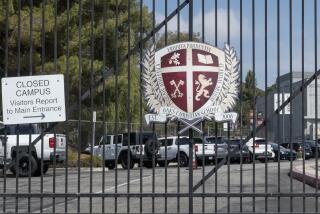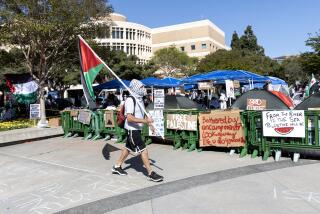PERSPECTIVE ON RACE RELATIONS : Can We All Get Along? Not Yet : Until blacks are regarded as ‘ordinary’ Americans, little social disputes will take on extraordinary racial dimensions.
- Share via
PHILADELPHIA — The University of Pennsylvania has been in the news lately as a campus seething over race-based harassment, the so-called water-buffalo incident, in which a white male student is alleged to have insulted a group of African-American female students. To understand why this has become such an emotionally charged issue, one drawing national attention, it must be seen in the general context of contemporary American race relations.
The incident grows out of the unfinished business of the civil-rights movement and the incomplete inclusion of blacks into mainstream society. That passage of inclusion has been made incredibly more difficult by the tense atmosphere that surrounds much of the racial coexistence that has been achieved. In addition, this incident must be viewed in the context of 12 years of national retreat on race matters.
In the late 1960s, in the midst of the civil-rights movement, college campuses were generally tolerant of the idea of black presence--partly because black presence was virtually nil. Today, as college students and other Americans sense a shrinking economic pie, more people question the value of affirmative action, and some whites feel that they now suffer as a result of black gains. At the same time, the racial and ethnic configuration on campus has changed. Students now come from a greater variety of backgrounds, including lower-middle class backgrounds traditionally less tolerant of others outside their group, in large part due to decades of competition for jobs and neighborhoods. Moreover, many whites feel put upon to some extent, asking why blacks have any “special treatment.”
People who hold such attitudes very often ignore the peculiar racial history of the country in which blacks have been left out of so much. These whites have no real sympathy for government actions to remedy decades of second-class citizenship, and some let their feelings be known by physical and verbal acts of intolerance, which then result in the kind of frictions that become interpreted and defined as racial tension, even if the problem was not initially caused by prejudice.
The consequences of persistent racial tension can be found all over this country, not just at Penn, but at Dartmouth, Duke, the University of Massachusetts and others. Some schools, Penn among them, have responded by putting in place institutional mechanisms to adjudicate these incidents. To its credit, Penn has formulated a racial harassment policy, but a policy cannot of itself change attitudes; nor does the process satisfy everyone. In all of these places, there is a vocal minority of students on either side of the line who have been conditioned to see the campus as contested terrain. They look on members of the other group with suspicion and distrust and are more than ready to approach one event or circumstance with hostility.
Whenever black students gather, they become something of a spectacle for others who may be ready to insult them. Occasionally an incident does occur, especially when the people who do the insulting think they can’t be identified. One black professor told me, for example, that he had eggs thrown at him from a dorm window one night. Of course, not all white students--or even most--are engaging in this kind of behavior, but enough are to make life uncomfortable for blacks.
In such an uneasy environment, any activity that causes irritation--speeding bicyclists, loud marching bands, rowdy fraternity parties--can quickly take on a peculiar racial meaning when black students are involved. These students complain that the campus police consistently treat them more harshly than they treat white students who engage in similar behavior. They are further frustrated by the knowledge that most white students are unaware of this state of affairs, since such incidents tend to occur at night when there are few witnesses and the student newspaper, the Daily Pennsylvanian, ignores them.
In the recent incident at Penn that did get press coverage, nationally, it appears that a number of black women were outdoors celebrating their sorority’s founding. It was near midnight, and people on the sixth floor of a nearby high-rise dormitory claimed to be disturbed. This happened in January, and there is a question as to how much noise penetrated the building, but at any rate, a number of students in the building began yelling racial epithets at the women. One young man evidently shouted, “Shut up, water buffalo!” This student was the only one to admit having said anything, but he insists that what he said was not a racial slur. However, other students were heard yelling pointedly racial slurs.
The term “water buffalo,” which I’ve never heard used as a racial epithet, easily becomes interpreted as such because of the context. Ordinarily, this would just be a normal dispute among students, but because the people involved are of a different color, the friction can be defined by the participants as racial. It becomes hard for blacks to believe that this white male student did not have racial connotations in mind. They ask, “what if . . . ?” What if the women had been white? Would they have been subjected to similar abuse? Blacks think not.
Not all white students are resistant to black presence at Penn, but some really do feel threatened as black students begin to make their presence felt as ordinary students. These white students take exception to black students claiming to be full persons on campus and hold them especially accountable for not walking a very sharp line of propriety. Any deviance that a black student displays is likely to be magnified, especially by those who are intolerant of the diversity that blacks add to the campus.
Willfully ignorant of conditions for blacks in this country before the civil- rights movement, many white students view affirmative action as a bad policy, one that has a negative impact directly on them and their friends. These same students feel that they are exercising their right of free speech--no matter how hurtful--by reminding blacks that they are outsiders, marginal people lacking full rights, obligations and duties. The resulting polarization makes black students feel that whites are outsiders in the struggle for an egalitarian society.
The fact that blacks have to assert “I am a full citizen” speaks volumes about their actual sense of inclusion in university life and the social tightrope they walk. The Daily Pennsylvanian is viewed by many black students as racist, inclined to remind blacks repeatedly of their inferior status on Penn’s campus. With this in mind, some black students sought to demonstrate their profound dissatisfaction with this organ that represents the student body at Penn by intercepting and throwing away most of one day’s copies. To many, this protest was successful because it drew attention to the desperate plight of black students on campus.
So each camp approaches the other with something of a deficit model in mind. Each group has a hole to get out of before it can begin to communicate with the other. In this context, it is hard for them to see one another without prejudice, and the result is that ordinary behavior engaged in by students who are not yet deemed ordinary becomes racially significant.
More to Read
Sign up for Essential California
The most important California stories and recommendations in your inbox every morning.
You may occasionally receive promotional content from the Los Angeles Times.













